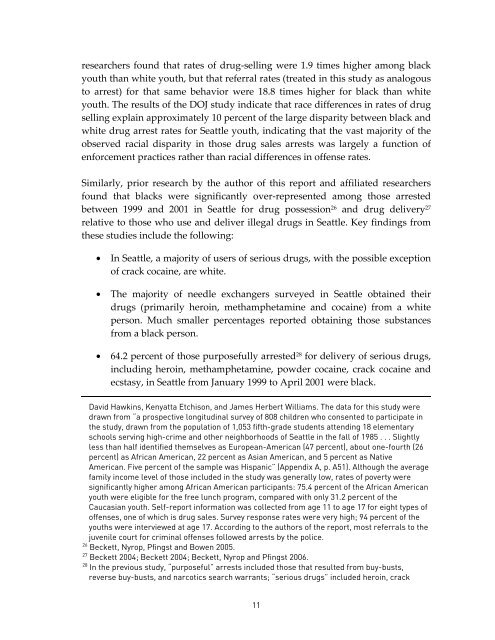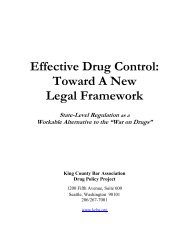RACE AND THE ENFORCEMENT OF DRUG DELIVERY LAWS IN ...
RACE AND THE ENFORCEMENT OF DRUG DELIVERY LAWS IN ...
RACE AND THE ENFORCEMENT OF DRUG DELIVERY LAWS IN ...
You also want an ePaper? Increase the reach of your titles
YUMPU automatically turns print PDFs into web optimized ePapers that Google loves.
esearchers found that rates of drug-selling were 1.9 times higher among black<br />
youth than white youth, but that referral rates (treated in this study as analogous<br />
to arrest) for that same behavior were 18.8 times higher for black than white<br />
youth. The results of the DOJ study indicate that race differences in rates of drug<br />
selling explain approximately 10 percent of the large disparity between black and<br />
white drug arrest rates for Seattle youth, indicating that the vast majority of the<br />
observed racial disparity in those drug sales arrests was largely a function of<br />
enforcement practices rather than racial differences in offense rates.<br />
Similarly, prior research by the author of this report and affiliated researchers<br />
found that blacks were significantly over-represented among those arrested<br />
between 1999 and 2001 in Seattle for drug possession 26 and drug delivery 27<br />
relative to those who use and deliver illegal drugs in Seattle. Key findings from<br />
these studies include the following:<br />
• In Seattle, a majority of users of serious drugs, with the possible exception<br />
of crack cocaine, are white.<br />
• The majority of needle exchangers surveyed in Seattle obtained their<br />
drugs (primarily heroin, methamphetamine and cocaine) from a white<br />
person. Much smaller percentages reported obtaining those substances<br />
from a black person.<br />
• 64.2 percent of those purposefully arrested 28 for delivery of serious drugs,<br />
including heroin, methamphetamine, powder cocaine, crack cocaine and<br />
ecstasy, in Seattle from January 1999 to April 2001 were black.<br />
David Hawkins, Kenyatta Etchison, and James Herbert Williams. The data for this study were<br />
drawn from “a prospective longitudinal survey of 808 children who consented to participate in<br />
the study, drawn from the population of 1,053 fifth-grade students attending 18 elementary<br />
schools serving high-crime and other neighborhoods of Seattle in the fall of 1985 . . . Slightly<br />
less than half identified themselves as European-American (47 percent), about one-fourth (26<br />
percent) as African American, 22 percent as Asian American, and 5 percent as Native<br />
American. Five percent of the sample was Hispanic” (Appendix A, p. A51). Although the average<br />
family income level of those included in the study was generally low, rates of poverty were<br />
significantly higher among African American participants: 75.4 percent of the African American<br />
youth were eligible for the free lunch program, compared with only 31.2 percent of the<br />
Caucasian youth. Self-report information was collected from age 11 to age 17 for eight types of<br />
offenses, one of which is drug sales. Survey response rates were very high; 94 percent of the<br />
youths were interviewed at age 17. According to the authors of the report, most referrals to the<br />
juvenile court for criminal offenses followed arrests by the police.<br />
26 Beckett, Nyrop, Pfingst and Bowen 2005.<br />
27<br />
Beckett 2004; Beckett 2004; Beckett, Nyrop and Pfingst 2006.<br />
28 In the previous study, “purposeful” arrests included those that resulted from buy-busts,<br />
reverse buy-busts, and narcotics search warrants; “serious drugs” included heroin, crack<br />
11

















